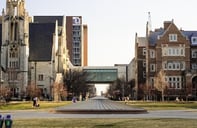Published on
Embedding Workforce Education Across the Modern College

The modern community college serves a wide range of individuals pursuing a diverse array of goals. But what unites many individuals coming through the doors of their local college is a shared desire to accomplish job or career outcomes. In this interview, Chris Lowery shares his thoughts on how colleges can embed career outcomes into programming offered across the college and reflects on what it takes to ensure the modern college truly honors all learners that turn to the college for help.
The EvoLLLution (Evo): What role does workforce education play in meeting the mission of a modern community college?
Chris Lowery (CL): Workforce education is central to meeting the mission of the modern community college. In fact, Gallup quantified that over 60% of students heading to a community college are doing so for career purposes.
The research tells us that our students are coming here for the ABCs: A job, a Better job or a Career.
In Indiana—as with other states—about half the jobs that will need to be filled over the next decade are in the middle-skill space, where you need more than a high school diploma but not necessarily a bachelor’s degree. For our state, that translates to at least 500,000 out of roughly a million jobs that will need to be filled because of growth or attrition.
It’s clear that the community colleges play a hugely important role in supporting our labor market and economy.
Evo: Why does higher education still have a cultural gap between the formal “academy” and the purpose and delivery of workforce education?
CL: As an industry, we have historically focused on serving traditional-age, 18 to 24-year old students. But in Indiana, there are roughly two million working-age adults without credentials beyond a high school diploma.
That’s going to be a challenge for the economy and for employers over the next several years—and for these two million individuals it’ going to pose a challenge to them for their entire work lives.
So we have to be more intentional in honoring our adults. Let’s take a person in her mid-50s, who started a company with her family members 30 years ago. Their company’s facility grew from 800 sq. ft. to 800,000 sq. ft., from a couple of people to a thousand, and they generate a quarter billion dollars in revenue. But this person doesn’t have a college degree.
If she came to a higher education institution to earn a business degree, she would likely have to take introductory courses to get on track. Meanwhile, this individual is thinking, “I’ve run a profitable business for 30 years. I not only know about a balance sheet, cash flow, income statements and so forth, but I’ve lived them.”
I’m dramatizing a bit, but this hypothetical situation I’ve just described broadly represents the experience of a good friend of mine.
So we should ask ourselves if our traditional degree pathways are truly honoring the students enrolling in those programs. There’s not enough consideration for the experience and insights adult learners bring with them. We’re beginning to introduce competency-based education, but we need to be thinking more about prior learning and experiences.
Another gap relates to how we’re informing the choices students make early on.
A couple of years ago, we decided to completely redo our career services because it was ineffective and wholly inadequate. As with many institutions, it was understaffed and lacked an outcome focus for students. Today, the focus is on coaching, which students really need. We also highlight realities of supply and demand using economic data, and we create access to experiences to help show students what their better job or career might look like.
Our students compete a career development portfolio, which is iterative through their experience with us. It requires career assessments, development of resumes, LinkedIn profiles, employer engagement, work-and-learn experiences and other tangible actions leading to stronger career and wage outcomes.
We adopted true intentionality into our career coaching and employer connections strategy, and focus on bridging the gap between education and the labor market.
Evo: From an infrastructural perspective, what are the challenges to managing and scaling non-credit workforce education across a 19-campus system like Ivy Tech?
CL: Geographic and economic sector differences across the state can present challenges. But we have excellent relationships with employers and industries across the state that help us deliver continuous value.
We take a quantitative and qualitative approach to the workforce at a statewide and local level. Every year, we do a supply and demand assessment and match it up to understand what we should be offering from an aggregated state view. Then we do that analysis at each of our 19 campus service areas, which together cover the entire state.
Our campus leaders then do this work from a more qualitative standpoint with local employer advisors. Currently, we are providing some form of training or education to over 2,000 employers across the state. That’s really helpful from a business intelligence standpoint.
The quantitative and qualitative analyses we do at the state and local levels allow for adaptation. For example, we can move with greater speed if the state has recruited a certain type of business to a community and that’s part of the shifting landscape, or maybe a business in a community has recently merged with another and possibly moved to another location. The insights are closer to real time.
Evo: How does balance get struck between what happens at the system level and how it’s executed at the campus level?
CL: A lot of strategic plans end up in a binder or somewhere on a hard drive, and there they sit, right? At Ivy Tech, we see the strategic plan as a living, breathing document and roadmap.
We have eight strategic goals, and the very first one is student success. The student is at the center of all we do. We start every consideration with an understanding that here’s the student in the center, and then we move concentrically from there in terms of what are we doing in support of that individual.
That is critically important for our organization as we try to lead through complexities related to our students’ lives, our economy and our own organization.
Ivy Tech is the nation’s largest singly accredited community college, which is convenient when accreditation renewal comes forth, but the work is also complex. In addition, we have a matrix organization with 19 campuses, each empowered and accountable in this work. Yet, everyone knows student success is the number one goal.
We try to also be thoughtful. For example, when we do the supply and demand analyses, respective campus chancellors are talking with each other to understand market needs and offerings. They are saying to each other things like, “Hey, we don’t really have the need over here. You’ve got the program and the capacity. So, we want to make sure students in our service area know about those specific non-credit training or academic programs.”
Evo: How do you start to see that pathway between non-credit and credit being formalized in a scalable way?
CL: About four years ago, we recognized the need to create more robust and intentional pathways from non-credit to credit education. Two things that are unique about our system were helpful to accomplishing this goal.
First, my position was actually created by statute, which is really different, and requires a broad focus as the chief workforce officer. So, a statutory expectation of my role is to focus on this alignment.
Second, our provost Kara Monroe and I are partners in approving all training and education offerings. We have the last say before the institution approves new programs or changes. This makes for purposeful alignment of our offerings across the spectrum, engagement that is student and employer centric, and advancement along a market demand curve.
The reality is that high-quality non-credit offerings—especially those resulting in industry certifications—often provide a great pulse on what’s going on in the economy. The speed at which they are created and brought to market says a lot about where the market is trending and where it’s likely going.
Evo: How do you create student buy-in for stackability and an understanding for non-credit credentials?
CL: First, it’s important to inform students how they can clearly stepladder their education toward both career and academic outcomes. The more we can share with the student about what associated jobs would ultimately look like as they continue their academic journey, the better.
Second, we intentionally embed high-value industry certifications into our programs. The student can then pursue the learning via non-credit training or a standard academic program.
All of this is more responsive to the needs of learners and employers as we think of this work as an ecosystem and not just in a linear fashion.
Evo: What do you and your team need to get from where you are today to this future state, where Workforce Development is this strategically integrated central piece of what the college does?
CL: Our primary need in all of this continues to be greater engagement with employers. That’s always a significant factor. I said the first element in our strategy is student success. The student is always right at the center of things, but closely following is the employer.
I can’t think of how many times a week I will put in a note or say out loud; “Students, employers and communities.” If we have those three things in focus as the community college in Indiana, that’s always going to be good.
A challenge with employers is that they’re really busy, but their deep engagement is critical. Employers are probably busier than ever because of some of these challenges we’ve started to see in the market. So, the better connected to them we are, the better we will serve students and communities.
I’ll go back to the challenge of helping people understand what career choices they might be making and that it doesn’t have to be just a four-year degree. In fact, it could be this non-credit industry certification that gets an individual in the door of an employer on the way to building a career. Lifelong learning, coming into and out of training and education, is probably only going to accelerate as technology accelerates.
This interview was edited for length and clarity.
Author Perspective: Administrator
Author Perspective: Community College



